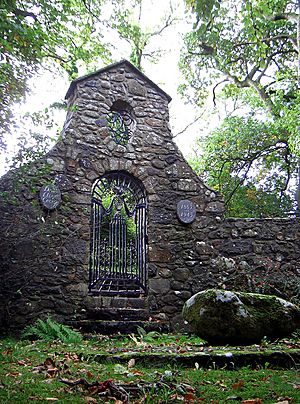Grave of David Lloyd George facts for kids
Quick facts for kids Grave of David Lloyd George |
|
|---|---|

“a hero’s burying-place”
|
|
| Type | Grave |
| Location | Llanystumdwy, Gwynedd |
| Area | North Wales |
| Built | 1946 |
| Architect | Clough Williams-Ellis |
| Architectural style(s) | Vernacular |
|
Listed Building – Grade II
|
|
| Official name: Grave of David Lloyd George | |
| Designated | 31 March 1999 |
| Reference no. | 21601 |
| Lua error in Module:Location_map at line 420: attempt to index field 'wikibase' (a nil value). | |
The Grave of David Lloyd George is a special place in the village of Llanystumdwy, Gwynedd, Wales. It sits right by the Afon Dwyfor river. This grave honors David Lloyd George, a very important person who grew up in this village. He was the Prime Minister of the United Kingdom (the leader of the British government) from 1916 to 1922. Lloyd George passed away in Llanystumdwy in 1945.
The design of his grave and the area around it was created by Clough Williams-Ellis. He was a famous architect who designed the unique village of Portmeirion. Clough Williams-Ellis was also a close friend of Lloyd George throughout his life. The grave itself is a large rock, placed inside an oval-shaped area. The walls of this area have two special slate plaques. These plaques show Lloyd George's name and the years he was born and died. This grave is considered a very important historical site, known as a Grade II* listed structure.
Contents
David Lloyd George's Early Life
David Lloyd George was born in a place called Chorlton-on-Medlock, Manchester, on January 17, 1863. When he was just a baby, his family moved to Pembrokeshire. Sadly, his father passed away the next year. This led his family to move again, this time to his mother's home village of Llanystumdwy. This village is in what was then called Caernarfonshire, which is now Gwynedd. They lived there with Lloyd George's uncle, Robert Lloyd.
David Lloyd George became a solicitor (a type of lawyer) in 1884. In 1890, he was elected to Parliament. This meant he became a M.P. for Carnarvon Boroughs, representing the Liberal Party.
Becoming Prime Minister
Lloyd George started out as a more radical member of the Liberal Party. In 1916, during World War I, he became the Prime Minister of the United Kingdom. He led the country as part of a team with the Conservatives. He was very successful in leading Britain during the war.
However, after the war, he lost his position as Prime Minister in 1922. He never returned to power after that. David Lloyd George passed away from cancer on March 26, 1945, when he was 82 years old. He was buried in Llanystumdwy, just as he had wished.
Choosing His Resting Place
Lloyd George had always wanted to be buried by the Afon Dwyfor river. He told his wife, Margaret Lloyd George, "I don't want to be buried anywhere else." In 1922, he took a friend, Thomas Jones, to Llanystumdwy. By the river, he told him, "Bury me here. Don't put me in a cemetery." He also suggested what he wanted written on his grave. He wanted it to say: "Magwyd yn y pentref. Prif Weinidog Prydain yn y Rhyfel Mawr" (meaning: "Bred in the village. Prime Minister of Britain in the Great War").
After Lloyd George passed away, his second wife, Frances Stevenson, asked his friend Clough Williams-Ellis to design the grave site. Even with rules about building after the war, the work was done quickly. The grave was finished in March 1946.
The Grave's Design
Bedd David Lloyd George (Iarll Dwyfor),
Y maen garw, a maen ei goron, – yw bedd
Gŵr i’w bobl fu’n wron;
Dyfrliw hardd yw Dwyfor lon,
Anwesa’r bedd yn gyson.
The Grave of David Lloyd George (Earl Dwyfor),
The rough stone, and the stone of his crown – is the grave
Of a man who was a hero to his people;
Merry Dwyfor is a beautiful watercolour,
That continuously embraces the grave.
The main part of the grave's design is a large boulder (a big rock) from the Afon Dwyfor river. Lloyd George used to sit on this very rock. He is buried underneath it. The boulder sits on a base decorated with small stones from the beach at Criccieth.
The boulder is inside an oval-shaped area. This area is surrounded by a wall made of local stone. You enter through a fancy wrought iron gate set into an archway. Above the gate, there's a plaque made of Welsh slate. On it is an englyn (a traditional Welsh poem) written by Lloyd George's nephew, W. R. P. George. The letters were carved by Jonah Jones. There's also a round opening with the initials DLG (for David Lloyd George) made from wrought iron.
Inside the gate, on both sides of the wall, are two more plaques. They have his name, David Lloyd George, and the years he was born and died. The walls are about 1 meter (3 feet) high and curve towards the river. A path goes down 14 steps, ending at the river bank. From there, you are at eye level with the big boulder.
Experts describe the site as "a hero's burying-place and a consummate work of landscape design." Cadw, the Welsh government's historic environment service, calls it a "subtle and expressively designed memorial." It's a very special place designed by a leading Welsh architect for one of Britain's most important Prime Ministers.

